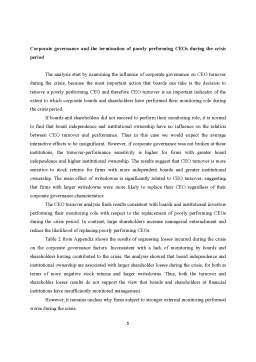Extras din proiect
The paper “Corporate governance in the 2007-2008 financial crisis: evidence from financial institutions worldwide” examines the role of corporate governance in the financial crisis.
A large number of financial institutions have collapsed or were bailed out by governments worldwide since the beginning of the global financial crisis in 2007. While governance reforms are being considered to reinstate the stability of global financial systems, there is little evidence on the role that corporate governance played in the financial crisis.
The authors investigate the role of corporate governance in the financial crisis using a dataset comprised of 296 of the world’s largest financial companies across 30 countries, for which they collect data on board characteristics, ownership structure, CEOs, firm performance, and risk-taking.
The analysis begins at the start of 2007 because this is generally considered as the period when the markets first become conscious of the importance of the losses related to subprime mortgages. The investigation period ends in the third quarter of 2008 for three main reasons:
(1) The substantial government bailouts were initiated from October 2008 onwards, and therefore the authors examine CEO turnover over the prior period in which it is driven mostly by internal corporate governance mechanisms.
(2) In October 2008, changes in the International Financial Reporting Standards (IFRS) allowed financial institutions to avoid recognizing asset writedowns.
(3) At the end of the third quarter of 2008, regulators in several countries required short-selling bans on the stocks of many financial institutions.
The sample consists of 296 publicly-listed financial firms (banks, brokerage firms, and insurance companies) that were publicly listed at the end of December 2006 across 30 countries. The following criteria were used to compile the sample. First, firms needed to be covered in the
Compustat North America or Compustat Global databases and have data on total assets, total shareholder’s equity, earnings, and stock returns. Second, the sample was limited to firms that are covered by the BoardEx and FactSet/Lionshares databases. Third, the sample is restricted to industries for which Bloomberg collected data on writedowns during the crisis period. Fourth, the firms must have total assets greater than US $10 billion because most of the debate focuses
on large global financial institutions.
Measuring CEO turnover
The authors employs biographic information on individual executives from BoardEx to determine the identity of the CEO for each firm. BoardEx contains detailed biographic information on individual executives and board members of approximately 12,000 publicly listed firms in nearly 50 countries and its coverage for international firms is unparalleled by any other data provider.
Figure 1 from Appendix shows the CEO turnover rates for financial versus non-financial firms from 2004-2008 worldwide. We can observe that financial firms revealed higher CEO turnover rates than those of non-financial firms in 2008, while in the 2004-2007 period the pattern was the opposite. The data also suggest a wide cross-country variation in CEO turnover. For example, five CEOs of the top ten financial firms in the U.S. were replaced during the sample period: the CEOs of Citigroup, AIG, Fannie Mae, Merrill Lynch, and Wachovia.
Measuring shareholder losses
A unique characteristic is that shareholder losses of financial firms are well publicized during the crisis period. They employ two variables to capture losses:
(1) Cumulative stock returns
(2) Cumulative writedowns scaled by total assets. Writedowns were measured as negative figures so that the regression coefficients on writedowns can be compared to those on stock returns.
Figure 2 from Appendix plots the magnitude of writedowns per quarter for all financial firms covered in Bloomberg. They classify writedowns into three categories:
- losses related to mortgage-backed securities
- losses related to loan portfolios
- losses related to investments in other firms
The figure shows a spike in writedowns related to mortgage-backed securities in the fourth
quarter of 2007, followed later on by an increase in writedowns related to investments in other
firms (such as in Lehman Brothers or Icelandic banks). It also shows a steady increase in credit
losses related to loan portfolios from the second quarter of 2007 to the third quarter of 2008.
Measuring corporate governance
The analysis is focused on firms’ corporate boards and ownership structures, the two key firm specific governance mechanisms. These corporate governance mechanisms are calculated as of December 2006. For boards of directors, they focus on board independence because this is one of the most extensively studied board characteristics. Board independence is defined as the percentage of independent directors. BoardEx data classifies directors as “independent” if they are non-executive directors.
Preview document
Conținut arhivă zip
- Corporate Governance in The 2007-2008 Financial Crisis.doc

















